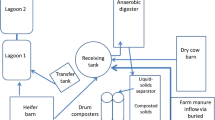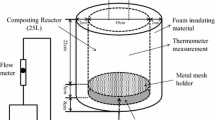Abstract
Pathogenic microorganisms may survive the composting process in low numbers and subsequently regrow to high levels under favorable conditions. The objective of this study was to investigate the regrowth potential of Salmonella spp., Escherichia coli O157:H7, and Listeria monocytogenes in dairy-based composts under different environmental conditions. Water extract of commercially available dairy compost was used as a model system. Cocktails of five rifampin-resistant strains of each pathogen previously grown in reduced nutrient media (1/2 or 1/10 strength of tryptic soy broth, TSB) were inoculated into water extract of compost of different ratios (1:2,1:5, and 1:10, w/v), and then stored at 35°C or 22°C for 7 days. The strains exhibiting greatest survival or regrowth were identified by pulsed-field gel electrophoresis (PFGE). At 22°C, both E. coli O157:H7 and L. monocytogenes multiplied in all compost extracts, whereas Salmonella spp. regrew in both 1:2 and 1:5 compost extracts but not in 1:10. For all three pathogens, incubation at 22°C provides better conditions for regrowth than at 35°C. Both Salmonella and E. coli O157:H7 previously adapted to nutrient-limited broth (1/10 strength of TSB) regrew in compost extracts to higher populations than the control cultures grown previously in full strength of TSB. In the absence of indigenous microorganisms, all three pathogens regrew even in the most diluted sterile compost extract (1:10) with growth potentials ranging from 2.30 to 3.59 log CFU/ml. In nonsterile compost extract with ca. 5 log CFU/ml of background microorganisms, all three pathogens regrew only in the most concentrated compost extract (1:2) with much less population increases ranging from 0.70 to 1.43 log CFU/ml. Compost extract samples of all ages supported the regrowth of both Salmonella and E. coli O157:H7 with population increases ranging from 0.95 to 2.32 log CFU/ml. The PFGE patterns for E. coli O157:H7 isolates from sterile compost extracts matched with either the spinach outbreak strain or an avirulent B6914 strain. These results demonstrated that compost extract of dairy-based compost contained sufficient nutrients for pathogen regrowth. Cultures previously adapted to low nutrient media regrew to higher populations than control cultures; however, indigenous microflora suppressed the pathogen regrowth in compost extract, especially at 35°C.


Similar content being viewed by others
References
Abee T, Wouters JA (1999) Microbial stress response in minimal processing. Int J Food Microbiol 50:65–91
Akanbi WB, Adebayo TA, Togun OA, Adeyeye AS, Olaniran OA (2007) The use of compost extract as foliar spray nutrient source and botanical insecticide in Telfairia oxxidentalis. World J Agric Sci 3:642–652
Benito A, Ventoura G, Casadei M, Robinson T, Mackey B (1999) Variations in resistance of natural isolates of Escherichia coli O157 to high hydrostatic pressure, mild heat, and other stresses. Appl Environ Microbiol 65:1564–1569
Brandon JR, Burge WD, Enkiri NK (1977) Inactivation by ionizing radiation of Salmonella enteritidis serotype Montevideo grown in composted sewage sludge. Appl Environ Microbiol 33:1011–1012
Buck JW, Walcott RR, Beuchat LR (2003) Recent trends in microbiological safety of fruits and vegetables (On-line). Plant Health Progress. doi:10.1094/PHP-2003-0121-01-RV
Centers for Disease Control, Prevention (2006) Ongoing multistate outbreak of Escherichia coli serotype O157:H7 infections associated with consumption of fresh spinach—United States, Sep. 2006. Morb Mortal Wkly Rep 38:1045–1046
CDC/PulseNet One-Day (24–28 h) Standardized Laboratory Protocol for Molecular Subtyping of Escherichia coli O157:H7, non-typhoidal Salmonella serotypes, and Shigella sonnei by Pulsed Field Gel Electrophoresis (PFGE) Available at: http://www.cdc.gov/pulsenet/protocols/ecoli_salmonella_shigella_protocols.pdf. Accessed on January 5, 2008
Cekmecelioglu D, Demirci A, Graves RE, Davitt NH (2005) Optimization of windrow food waste composting to inactivate pathogenic microorganisms. Trans ASAE 48:2023–2032
Dong T, Joyce C, Schellhorn HE (2007) The role of RpoS in bacterial adaptation. In: El-Sharoud W (ed) Bacterial physiology—a molecular approach. Springer, Berlin, pp 313–337
Doyle MP, Erickson MC (2008) Summer meeting 2007—the problems with fresh produce: an overview. J Appl Microbiol 105:317–330
Duffy B, Sarreal C, Ravva S, Stanker L (2004) Effect of molasses on regrowth of Escherichia coli O157:H7 and Salmonella in compost teas. Compost Sci Util 12:93–96
Epstein E, Wilson GB (1975) Composting raw sludge. In: Municipal Sludge Management and Disposal. Information Transfer, Inc., Rockville
Graves LM, Swaminathan B (2001) PulseNet standardized protocol for subtyping Listeria monocytogenes by macrorestriction and pulsed-field gel electrophoresis. Int J Food Microbiol 65:55–62
Giskin M, Nerson H (1984) Foliar nutrition of muskmelon: I: Application to seedlings greenhouse experiments. J Plant Nutr 7:1329–1339
Hussong D, Burger WD, Enkiri NK (1985) Occurrence, growth, and suppression of Salmonellae in composted sewage sludge. Appl Environ Microbiol 50:887–893
Ibanez-Ruiz M, Robbe-Saule V, Hermant D, Labrude S, Norel F (2000) Identification of RpoS (σS)-regulated genes in Salmonella enterica serovar Typhimurium. J Bacteriol 182:5749–5756
Ingram DT, Millner PD (2007) Factors affecting compost tea as a potential source of Escherichia coli and Salmonella on fresh produce. J Food Prot 70:828–834
Jay JM (2000) Intrinsic and extrinsic parameters of foods that affect microbial growth. In: Modern food microbiology. 6th ed. Aspen Publisher, Inc., Gaithersburg, pp 35–41
Jiang X, Morgan J, Doyle MP (2003) Fate of Escherichia coli O157:H7 during composting of bovine manure in a laboratory-scale bioreactor. J Food Prot 66:25–30
Jiang X, Morgan J, Doyle MP (2003) Thermal inactivation of Escherichia coli O157:H7 in cow manure compost. J Food Prot 66:1771–1777
Leenanon B, Drake MA (2001) Acid stress, starvation, and cold stress affect post stress behavior of Escherichia coli O157:H7 and nonpathogenic E. coli. J Food Prot 64:970–974
Lemunier M, Francou C, Rousseaux S, Houot S, Dantigny P, Piveteau P, Guzzo J (2005) Long-term survival of pathogenic and sanitation indicator bacteria in experimental biowaste composts. Appl Environ Microbiol 71:5779–5786
Litterrick AM, Harrier L, Wallace P, Watson CA, Wood M (2004) The role of uncomposted materials, composts, manures, and compost extracts in reducing pest and disease incidence and severity in sustainable temperate agricultural and horticultural crop production—a review. Crit Rev Plant Sci 23:453–479
Lung AJ, Lin CM, Kim JM, Marchall MR, Nordstedt R, Thompson NP, Wei CI (2001) Destruction of Escherichia coli O157:H7 and Salmonella enteritidis in cow manure composting. J Food Prot 64:1309–1314
Millner PD, Powers KE, Enkiri NK, Burge WD (1987) Microbially mediated growth suppression and death of Salmonella in composted sewage sludge. Microb Ecol 14:255–265
National Organic Standards Board (2004) Compost tea task force report. Available at: http://www.ams.usda.gov/AMSv1.0/getfile?dDocName=STELPRDC5058470. Accessed on February 15, 2009
Rahn K, Renwick SA, Johnson RP, Wilson JB, Clarke RC, Alves D, Mcewen S, Lior H, Spika J (1997) Persistence of Escherichia coli O157:H7 in dairy cattle and the dairy farm environment. Epidemiol Infec 119:251–259
Rice LB, Bonomo RA (2005) Genetic and biochemical mechanisms of bacterial resistance to antimicrobial agents. In: Lorian V (ed) Antibiotics in laboratory medicine, 5th edn. Lippincott Williams & Wilkins, Baltimore, pp 441–508
Rodriguez A, Pangloli P, Richards HA, Mount JR, Draughon FA (2006) Prevalence of Salmonella in diverse environmental farm samples. J Food Prot 69:2576–2580
Russ CF, Yanko WA (1981) Factors affecting Salmonellae repopulation in composted sludges. Appl Environ Microbiol 41:597–602
Ryu JH, Beuchat LR (1999) Changes in heat tolerance of Escherichia coli O157:H7 after exposure to acidic environments. Food Microbiol 16:317–324
Shepherd MW, Liang P, Jiang X, Doyle MP (2007) Fate of Escherichia coli O157:H7 during on-farm dairy manure-based composting. J Food Prot 70:2708–2716
Sidhu J, Gibbs RA, Ho GE, Unkovich I (2001) The role of indigenous microorganisms in suppression of Salmonella regrowth in composted biosolids. Water Res 35:913–920
Sivapalasingham S, Friedman CR, Cohen L, Tauxe RV (2004) Fresh produce: a growing cause of outbreaks of foodborne illness in the United States, 1973 through 1997. J Food Prot 67:2342–2353
Soares HM (1996) Pathogen indicator regrowth potential as a method to evaluate compost stability. Ph. D. Dissertation, University of Massachusetts at Amherst, Department of Civil and Environmental Engineering
Ueno H, Yokota K, Arai T, Muramatsu Y, Taniyama H, Iida T, Morita C (1996) The prevalence of Listeria monocytogenes in the environmental of dairy farms. Microbiol Immunol 40:121–124
Wang X, Jothikumar N, Griffiths MW (2004) Enrichment and DNA extraction protocols for the simultaneous detection of Salmonella and Listeria monocytogenes in raw sausage meat with multiplex real-time PCR. J Food Prot 67:189–192
Weber H, Polen T, Heuveling J, Wendisch VF, Hengge R (2005) Genome-wide analysis of the general stress response network in Escherichia coli: σS-dependent genes, promoters, and sigma factor selectivity. J Bacteriol 187:1591–1603
Weltzien HC (1990) The use of composted materials for leaf disease suppression in field crops. Monogr Br Crop Prot Counc 45:115–120
Yeager JG, Ward RL (1981) Effects of moisture content on long term survival and regrowth of bacteria in wastewater. Appl Environ Microbiol 41:1117–1122
Acknowledgment
This project was funded through a grant from the Fresh Express Produce Safety Initiative.
Author information
Authors and Affiliations
Corresponding author
Rights and permissions
About this article
Cite this article
Kim, J., Shepherd, M.W. & Jiang, X. Evaluating the Effect of Environmental Factors on Pathogen Regrowth in Compost Extract. Microb Ecol 58, 498–508 (2009). https://doi.org/10.1007/s00248-009-9524-x
Received:
Accepted:
Published:
Issue Date:
DOI: https://doi.org/10.1007/s00248-009-9524-x




